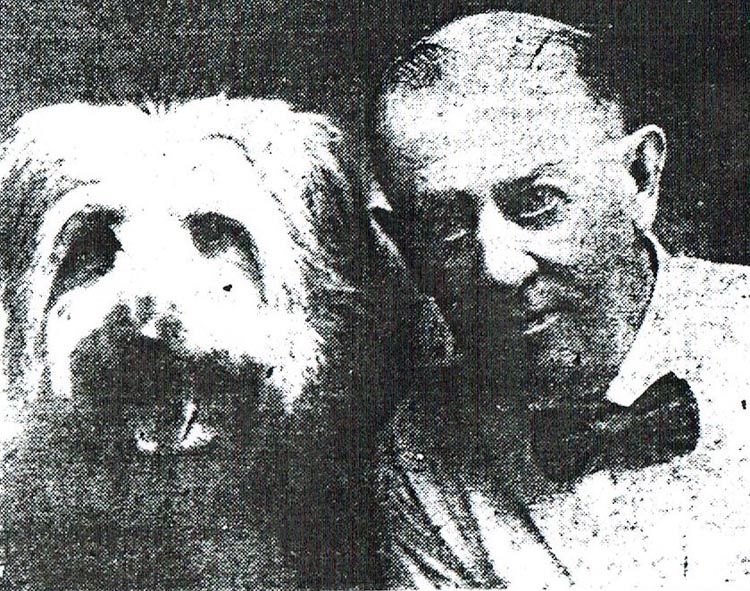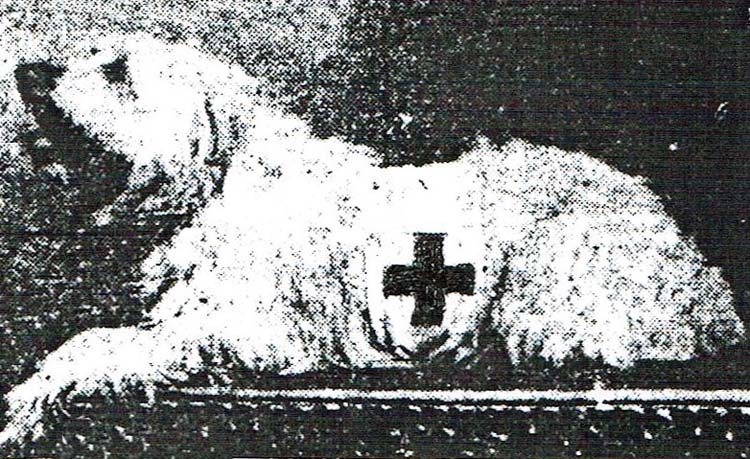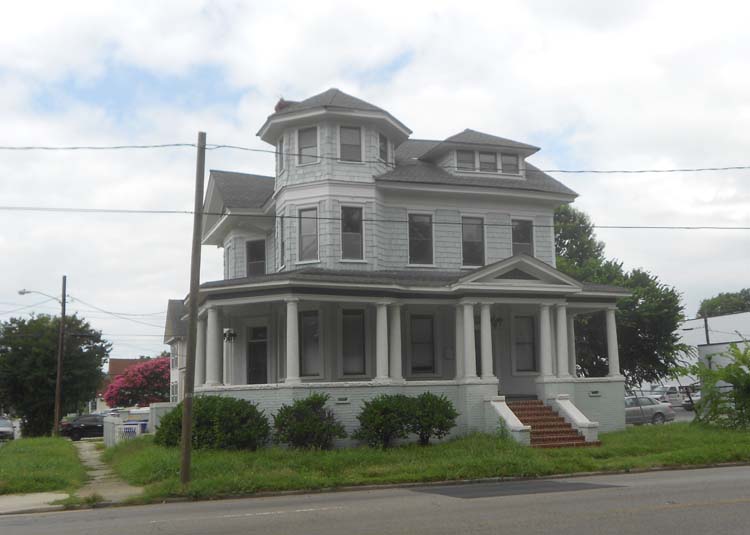Historical
Reminiscing with Robert B. Hitchings
Copyright.
All rights reserved.
A Sheep Dog Named Peggy
“It is amazing how much love and laughter they
bring into our lives
and even how much closer we become with each other because of them.”
John Grogan

Peggy & Richard J. Jones
There is an old saying, a dog is man’s best friend. But the dog is also a woman’s best friend. Dogs are truly God’s special creatures that are more affectionate than people. They are there for us in so many ways. Yes, I am a dog lover. I have had many dogs in my lifetime. And each dog is so special, no matter the breed, for they give away so much love and expect nothing in return. They are truly faithful friends.
Somewhere in Lafayette Park, Norfolk’s City Park, lies a special little grave of a much beloved shaggy dog. Between two large cedar trees in a special green spot and beneath the sod is the resting place of Peggy, the English sheepdog and heroine of World War I. Her name is Peggy and this is her story.
During WWI, the War to End All Wars, the British put to use many working dogs, similar as today in war-torn areas and today’s police departments. These working dogs were able to sniff out bombs, rats and to carry messages through the enemy lines, especially “No Man’s Land.” The most common breed of dogs in WWI were the German Shepherds, Doberman Pinchers and Airedale Terriers. However, the British also used Collies and English Sheepdogs throughout the various war theatres. Dogs were a big help in the trenches to kill off the rat population and other pests that came around. But mostly they gave moral support to the soldiers standing guard in the trenches. And Peggy was such a dog.
Peggy was a native of Suffolk, England, and came from a patriotic family including three brothers who actually served at the front with British forces.
Peggy, the sheep dog, was known as “Virginia’s Most Patriotic Dog” a heroine of World War I in Flanders Fields. She saved the lives of many men called Tommies, the common soldier known to all in England. However, by doing her heroic deeds, she herself was severely wounded many times. But most of all during the long battles she gave hope to the men in the trenches. She was their beautiful mascot.
After the war she and her owner Richard J. Jones settled in Norfolk, the Berkley section on Mulberry Lane. He showed off Peggy like she was a thoroughbred horse. He loved Peggy!
During the war Peggy sold thousands of dollars of Liberty Loan Bonds and War Saving Stamps and was featured in many newspapers and magazine articles throughout the country. And she appeared in movies too.
During the Humane Week, April 20th to 28th, 1919, in Norfolk, Virginia, Peggy was pictured with her owner in the Norfolk-Ledger-Dispatch.. By their picture was this little poem.Oh man looking up to the Father!
With Trust in His infinite grace,
Look down, in the turn, on His creatures
That know but the light of your face.
That know but the warmth of your loving,
That wince at a word or a blow;
Ah, all the depth of their anguish,
No mortal may know.
Yours in clouds or sunshine.
Richard E. JonesAfter the war she was in many patriotic parades with her owner Richard E. Jones. Many times she would march just ahead of the Red Cross contingent. Peggy was noted for her nice RED CROSS insignia band across her body that gave her distinction. She also carried a three star service flag in memory of her three brothers that served as dogs of war under the British forces in France.
At the 1921 May Day Celebration in Washington, DC, Peggy was invited to march with her owner with President Warren Harding’s favorite dog, Laddie Boy. Huge crowds were along the streets and these two dogs were a sight to see. After the parade, she and her owner were invited to meet President Warren Harding at the Whitehouse.
She also marched in the parades in Portsmouth and Suffolk. Little Peggy got around the Tidewater area.
On May 2nd Norfolk celebrated “American Day,” a day to remember the fallen sons and daughters who died in WWI. The whole city turned out to celebrate awareness of this past war. It was a gala not seen in Norfolk for many, many years. The newspapers reported over 50,000 witnessed this parade. The Navy, Army & Veterans of Foreign Wars all marched. Julius F. Lynch was the grand marshal. Detachments of Fort Monroe, American Legion, former service women, Young Women Christian Society, Salvation Army, American Legion, Norfolk Police, Norfolk Firemen, African-Americans organizations, Veterans of the Spanish American War and Civil War were all marching. Refreshments were given out at Commercial place in downtown Norfolk by the Red Cross.
And it was Peggy with her Red Cross insignia marching in front of all the servicemen with her owner that brought out much love and excitement especially with little folks and dog lovers everywhere.Mayor Albert Roper, City Manager Charles Ashburner, Colonel George C. Cabell, all of Norfolk, delivered the addresses at evangelist Billy Sunday’s Tabernacle on 21st and Monticello Avenue.
Than on November 11th, Veterans Day, the Norfolk Chapter No. 4 Disabled American Veterans of the World War had a large parade, called, “Forget-Me-Not,” a drive to remember the veterans. Peggy, the War Dog, was there to help make the parade a success. Yes, she raised much money for the cause.
In Richmond, Virginia, on November 23, 1921, Peggy was invited to participate in the huge parade honoring Marshal Ferdinand Foch (1851-1929). Foch was the French Supreme Allied Commander (General & Military Theorist) in WWI France. The parade was truly an imposing pageant where thousands of Richmonders turned out to greet this great Frenchman.
Before Peggy’s death, her owner Mr. Jones always remembered everyone in the Virginian-Pilot newspaper with a Christmas message; “Wishing all folks, A Dog Gone Glorious Christmas and a Prosperous New Year of 1923."
On May 16, 1925, Peggy passed away. She was a favorite dog to so many soldiers and children during and after World War I. She died at her owner’s home in Berkley from old war wounds she had received and that contributed to her death. Norfolk went into mourning.
The Veterans of Foreign Wars performed the military funeral with honors ordinarily accorded a soldier who has died in the line of duty. Her funeral service was a military one and not a religious service. A salute to the Dead was fired with rifles at her grave along with cannons in the distance.
The City Council of Norfolk gave permission for a grave to be dug at Lafayette Park, our City Park. As the newspaper stated on May 17, 1925, “Peggy, while soulless perhaps and who acted more by instinct than by reasoning, has typified unselfishness and sacrifice and other attributes which make men noble.”
Peggy’s body was at the L. L. Williamson Funeral Home, the former Shellhouse family home, later to be Gregory Funeral Home. That home is still standing across from City Park, not far from where Peggy was buried.
former L. L. Williamson Funeral HomeOn May 18, 1925, little Peggy, Comrade, was laid to rest in City Park under two beautiful shade trees. She was given a full Military Honors Funeral. Over 500 paid homage to this little dog. Never before in Norfolk and possibly never anywhere else have such honors been given for a dog, heroine of Flanders, buried with a flag draped over her little white casket in City Park.
Men, women, and children began to file by the little white casket. Many remembered her friendly bark and wagging her tail as she met so many. Four Boy Scouts served as pallbearers, Lester Gray, Woodrow Llewellyn, Bruce Granby, and Tom Williamson. After little Peggy was laid to rest, the eulogy was delivered by William R. Brookman, adjutant of the post. Sally Montagne sounded the taps. A moment of silence and then the cannon in the background began to boom.
After Peggy’s death, Post 392 Veterans of Foreign Wars decided to place a bronze tablet bearing the appropriate inscription over her grave. Whether the city gave permission for this memorial, I have not been able to find out.
The deeds of this little dog who spent her life in the service of mankind will not only linger in Norfolk hearts, but hearts of many WWI soldiers especially back home in England.
Peggy, the sheep dog, has fallen through the cracks of time. She was one of those special creatures from God. No one is around who remembers this little dog. But in her day she was a fantastic little dog that brought so much happiness to so many in her lifetime. Peggy was truly a best friend to so many.* * * * *
Robert B. Hitchings is a seventh generation Norfolk resident, graduating with an Associate's Degree in Biology from Old Dominion University and BA in history from Virginia Wesleyan University. During his studies he was awarded a scholarship at Emmanuel College, Cambridge, England, and he was an exchange student at Brooks-Westminster College, Oxford, England. From 1999-2014 he worked as head of the Sargeant Memorial History Room at Norfolk Public Library, and since then has headed the Wallace History Room at Chesapeake Public Library. He is also the President of the Norfolk County Historical Society, and for six years was a columnist for The Virginian-Pilot. Robert may be reached at nchs.wallaceroom@gmail.com

